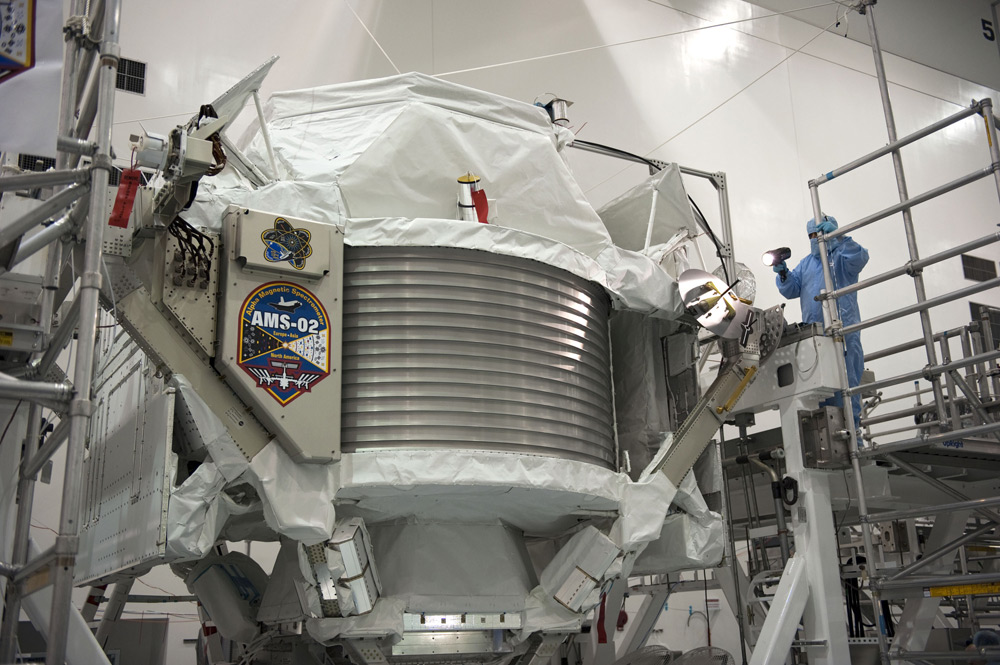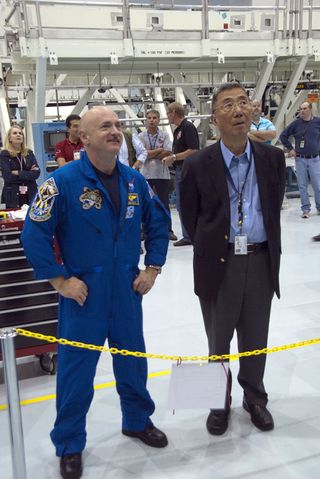Antimatter Hunter: Q&A with Nobel Laureate Sam Ting

When the space shuttle Endeavour lifts off one last time on Monday (May 16), it won't just be the culmination of the orbiter's career. It will also bring to fruition a 15-year, $2 billion quest to launch a device called the Alpha Magnetic Spectrometer to space.
The bus-size Alpha Magnetic Spectrometer (AMS) is an astrophysics experiment that will use a magnet to detect cosmic ray particles. These particles could include bizarre antimatter or other exotic species that scientists hope will shed light on some of the greatest mysteries of the universe, such as the puzzling dark matter thought to pervade space. [Video: Sifting Through the Cosmic Sand for Dark Matter]
For all its promise, AMS almost never got to fly. Originally scheduled to launch aboard the shuttle Columbia, the experiment lost its transportation after that orbiter was destroyed, along with its crew, in 2003. It took a vote by Congress to add one more shuttle mission before NASA retired its fleet to deliver AMS to the International Space Station.
SPACE.com spoke to AMS's most ardent defender through its highs and lows, the experiment's principal investigator Samuel Ting, a physicist at the Massachusetts Institute of Technology:
SPACE.com: What did you think when the shuttle mission to deliver AMS was canceled?
Samuel Ting: It was canceled in October 2005.
The Department of Energy had a review by members of the National Academy of Sciences, also by Nobel laureates. They reviewed only on the science, and they said this is such an important experiment, you should continue. Similar reviews were carried out by many of the collaborating countries. Every country said we're going to finish this experiment, and, hopefully, NASA will find the opportunity to fly it. [Infographic: How the Alpha Magnetic Spectrometer Will Work]
Get the Space.com Newsletter
Breaking space news, the latest updates on rocket launches, skywatching events and more!
SPACE.com: How did you feel when the mission finally got the green light to fly?
Ting: I never had any doubt when they were going to fly. I think it was three days after the inauguration of President Obama, we were on the manifest. We didn't change the mission, we just continued.

SPACE.com: What question do you most hope the experiment will answer?
Ting: For us as experimental physicists, the most important thing to realize is really, now you are entering a new domain where people have not carefully explored before.
What we really will see, nobody will know, because you open the door into a new region. My most important responsibility is to make sure the instrument is correct. You don’t know what you will see, but you have to make sure what you see is correct. That's why we took the detector, took it apart, assembled it, took it apart, assembled it, took it apart, assembled it, three times.
SPACE.com: Why put AMS in space as opposed to on Earth?
Ting: We want to measure charged cosmic rays. You know, we live under 60 miles of atmosphere, it's like 30 feet of water. So original charged cosmic rays cannot be detected on Earth; therefore, you have to go to space. [Wacky Physics: The Coolest Little Particles in Nature]
SPACE.com: How likely is it that AMS will find dark matter?
Ting: For experimentalists, the most important thing is to not offer bias. My opinion and your opinion is the same. Unless you do observations, you will not know. Physics doesn't depend on vote. [If a] hundred people say this, one person says differently, doesn’t mean the hundred persons are correct.
SPACE.com: Why should people care about dark matter and antimatter?
Ting: The difference between humans and animals is curiosity. It's curiosity that drives a physicist forward to search for the unknown. Let me give you another reason.
A hundred years ago, the frontier of science is the discovery of electrons, and the discovery of X-rays. At that time, nobody cares. It's only from 1930s onward people know you can use for medicine, you can use for doing electronics.
In 1920s, 1930s, the frontier of science is quantum mechanics, quantum physics. At that time people asked the same question, how do we benefit from this?
Now, your IT, your telephone, your television, almost every[thing in] daily life, is from the work around 1930s. In 1940s the frontier of science was nuclear physics, nuclear energy. Now rightly or wrongly, it's being used.
From the discovery to application, there's a time lag, maybe 30 years, maybe 40 years, but once it's used, it changes everybody's life.
SPACE.com: How do you think you'll feel when Endeavour launches AMS?
Ting: When things are very important, I'm normally quite calm. [Photos: Shuttle Endeavour's Final Voyage]
I have to go to the control room to tell them "go" or "no go." I already made up my mind, I'm going to say "go."
SPACE.com: Will you open a bottle of champagne?
Ting: To start with, I don't drink. It's very important to be very calm, to know that your ability is limited, to do it slowly and carefully. Not jump up and down.
You can follow SPACE.com Senior Writer Clara Moskowitz on Twitter @ClaraMoskowitz. Follow SPACE.com for the latest in space science and exploration news on Twitter @Spacedotcomand on Facebook.
Join our Space Forums to keep talking space on the latest missions, night sky and more! And if you have a news tip, correction or comment, let us know at: community@space.com.

Clara Moskowitz is a science and space writer who joined the Space.com team in 2008 and served as Assistant Managing Editor from 2011 to 2013. Clara has a bachelor's degree in astronomy and physics from Wesleyan University, and a graduate certificate in science writing from the University of California, Santa Cruz. She covers everything from astronomy to human spaceflight and once aced a NASTAR suborbital spaceflight training program for space missions. Clara is currently Associate Editor of Scientific American. To see her latest project is, follow Clara on Twitter.